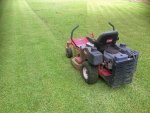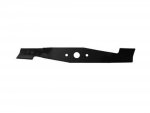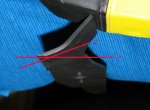You are using an out of date browser. It may not display this or other websites correctly.
You should upgrade or use an alternative browser.
You should upgrade or use an alternative browser.
Using a balancer on a mower blade
- Thread starter mois25
- Start date
More options
Export threadstevestd
Active Member
- Joined
- Aug 31, 2016
- Threads
- 1
- Messages
- 50
I know this seems hard to believe, but the wing tips wear out faster than the cutting edge. When the wing tips wear out and break off (dangerous), there is no lift left on the blade so although the mower will cut the grass, it will not mulch leaving obvious grass clippings on the lawn. The first picture shows a line where the grass cuts a groove in the blade (by friction) which then eventually turns into a hole; the tip will then break off, noting the blade is about 6mm thick (1/4 inch). A mulching deck works by lifting the grass back into the deck and re-cutting the grass numerous times. The down side is that the blades wear out a lot quicker than a side discharge mower. The plus side is that there is no grass to dispose of; the mulch is like dust on a dedicated machine/deck so you cannot tell that the lawn has been mulched; and you are not taking anything away from the lawn (nutrients and water). Back to the original thread, from my experience, the higher wear rate on mulching blades means that they need to be sharpened and thus balanced more often than side discharge mowers. The second picture shows the end result.
Attachments
Because the wins control the air flow under the deck.
The wing ( flute to some ) errodes at the bend then cracks then breaks off and goes flying out at 14,000 ft/ sec.
Good enough reason ?
Thank you for this explanation! I knew, what the rear side and the tip is doing during mowing, I just didn't know how much wear it can cause on that part of the blade.
Electric mowers blades need to have a closer balance tolerance than gas powered, as the shafts and bearing surfaces are smaller and will cause problems with very little vibration.
I can imagine, that this is true, for me the vibration of the handle bar that was really annoying and irritating because the frequency of it was similar to what you get from a handheld massage wand, but while you use that only for a few seconds on any part of your body, I had to grab and hold the handle bar of the mower for an hour and that was really uncomfortable, almost painful.
I know this seems hard to believe, but the wing tips wear out faster than the cutting edge. When the wing tips wear out and break off (dangerous), there is no lift left on the blade so although the mower will cut the grass, it will not mulch leaving obvious grass clippings on the lawn. The first picture shows a line where the grass cuts a groove in the blade (by friction) which then eventually turns into a hole; the tip will then break off, noting the blade is about 6mm thick (1/4 inch). A mulching deck works by lifting the grass back into the deck and re-cutting the grass numerous times. The down side is that the blades wear out a lot quicker than a side discharge mower. The plus side is that there is no grass to dispose of; the mulch is like dust on a dedicated machine/deck so you cannot tell that the lawn has been mulched; and you are not taking anything away from the lawn (nutrients and water). Back to the original thread, from my experience, the higher wear rate on mulching blades means that they need to be sharpened and thus balanced more often than side discharge mowers. The second picture shows the end result.
Thank you for the tutorial in fine details, now I can see your point. For one, I didn't get it first because the blade on my mower looks completely different and when I was trying to comprehend your previous explanations, it just didn't make sense. You can see a picture of its profile here, It is only a 3 mm thick blade, since I no longer have the old blade, I cannot check any wear that happened to any part of it besides the cutting edge.
Very nice end result!
Attachments
stevestd
Active Member
- Joined
- Aug 31, 2016
- Threads
- 1
- Messages
- 50
You mower appears to have a heavy blade with small bearings, so balance is probably more important than many other mowers. I also note that your blade has a lot of metal near the ends, again making balance more critical. It is curious why the cutting edge of the blade appears to be upside down, directing the cut grass downwards not upwards. I am sure there is a good reason for this, but I don’t know what it is. With a slower spin speed and the grass being directed downwards, it is easy to understand why you wouldn’t notice any wear on the wing tips.
Back to your original request, if the slots on the cone balancer don’t exactly fit your blade, why don't you try putting a bit of “Blu Tack” or similar on the cone to help centre the blade.
Better than nothing or a nail in the wall. See the video on this page http://www.lawnmowerforum.com/showthread.php/22507-Where-to-sharpen-blade/page9 . I have also found that new blades can be way out of balance.
Back to your original request, if the slots on the cone balancer don’t exactly fit your blade, why don't you try putting a bit of “Blu Tack” or similar on the cone to help centre the blade.
Better than nothing or a nail in the wall. See the video on this page http://www.lawnmowerforum.com/showthread.php/22507-Where-to-sharpen-blade/page9 . I have also found that new blades can be way out of balance.
The blade weights 390g (14 oz) and the motor has two "6203 2RS" (17x40x12mm) bearings. The blade is an original German design, but the Al-Ko made blades cost a lot more than the ones from the aftermarket.
In Hungary we use blades made by a Hungarian company according to Al-Ko specifications and I've heard that they've turned out to be so good quality that even Al-ko itself put their seal of approval on it and sells it also through its channels.
The only difference between the original Al-ko and the Hungarian blades is that the Hungarian one is made of a tiny bit softer metal than the Al-Ko one, so if you hit a piece of rock with it and it bends, you can easily bend it back in a wise, plus the chances of small pieces flying off of it is less than at the Al-ko blades, plus it is a lot cheaper for the consumers.
About the cutting edge being upside down - it's my "fault", i.e. I happened to take that picture in order to analyze the angle of the cutting edge from close up (25 degrees) and didn't care about how the blade is positioned when it's installed.
I decided to have a custom made ballancer made at a local machine shop, custom meaing, that it will work only with the current blade type with a 19.6mm diameter center hole. It will work exactly as the cone type, except it will be just an inch tall cylinder with a rim on the bottom and the top center of the cylinder inside will have a cone shaped "negative bump" similar to the cone ballancer.
BlazNT: What do you mean on the blade "bevel"?
In Hungary we use blades made by a Hungarian company according to Al-Ko specifications and I've heard that they've turned out to be so good quality that even Al-ko itself put their seal of approval on it and sells it also through its channels.
The only difference between the original Al-ko and the Hungarian blades is that the Hungarian one is made of a tiny bit softer metal than the Al-Ko one, so if you hit a piece of rock with it and it bends, you can easily bend it back in a wise, plus the chances of small pieces flying off of it is less than at the Al-ko blades, plus it is a lot cheaper for the consumers.
About the cutting edge being upside down - it's my "fault", i.e. I happened to take that picture in order to analyze the angle of the cutting edge from close up (25 degrees) and didn't care about how the blade is positioned when it's installed.
I decided to have a custom made ballancer made at a local machine shop, custom meaing, that it will work only with the current blade type with a 19.6mm diameter center hole. It will work exactly as the cone type, except it will be just an inch tall cylinder with a rim on the bottom and the top center of the cylinder inside will have a cone shaped "negative bump" similar to the cone ballancer.
BlazNT: What do you mean on the blade "bevel"?
stevestd
Active Member
- Joined
- Aug 31, 2016
- Threads
- 1
- Messages
- 50
Hi Géza,
Just to clarify as it is hard to determine from your previous photo. Is the horizontal plane, or the level/flat part of the blade similar to either line A or B in your previous photo attached (cut and rotated)? I had assumed it was line B which didn’t make any sense. If it is line A, then I can understand why the bevel or cutting edge is on the bottom and the blade would work.
Just to clarify as it is hard to determine from your previous photo. Is the horizontal plane, or the level/flat part of the blade similar to either line A or B in your previous photo attached (cut and rotated)? I had assumed it was line B which didn’t make any sense. If it is line A, then I can understand why the bevel or cutting edge is on the bottom and the blade would work.





